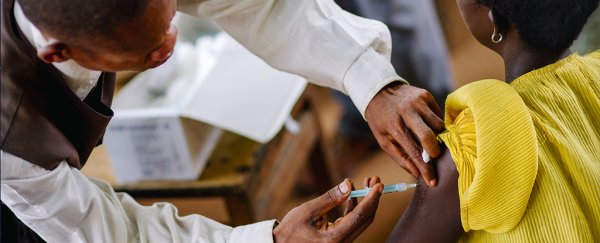A novel form of fabrication on a microscale level could mean we could one day receive a single vaccination that wouldn't require ongoing boosters.
Researchers have recently constructed tiny containers from a polymer that can be set to degrade inside the body at a specific time, allowing a drug or vaccine to be delivered in intervals over an extended period.
Described by their inventors as "tiny coffee cups", the 400 micrometre pods are made from poly lactic-co-glycolic acid (PLGA), a polymer already approved by the FDA as a potential drug-delivery material.
MIT engineers developed the production technique as part of a project funded by the Bill and Melinda Gates foundation with the aim of addressing the problem of vaccinating people in parts of the world where it's hard to deliver regular medical attention.
"This could have a significant impact on patients everywhere, especially in the developing world where patient compliance is particularly poor," says senior research Robert Langer from MIT.
Using PLGA to deliver controlled releases of medication isn't new.
Most existing technologies revolve around the particles disintegrating slowly, freeing the pharmaceuticals embedded in the polymer's matrix.
But by filling small containers with a substance, larger doses can be released in one hit.
The engineers developed a fabrication method called stamped assembly of polymer layers (or SEAL if you like your acronyms), which is more or less like making tiny soft-centre chocolates in the world's smallest silicon moulds.
In principle the technique could work with just about any thermoplastic material, opening the way to developing microstructures of just about any complex shape.
Once the cup has been moulded and filled, a tiny lid is added and heat-sealed in place.
Tweaking the properties of the PLGA changes the time it takes for the cup to fall apart, meaning it's possible to create a variety of containers that disintegrate at different stages on cue.
"We are very excited about this work because, for the first time, we can create a library of tiny, encased vaccine particles, each programmed to release at a precise, predictable time, so that people could potentially receive a single injection that, in effect, would have multiple boosters already built into it," says Langer.
The researchers showed in mice the particles successfully held their contents without leaking, and then released them in four stages between 9 and 41 days after injection.
Technically this could have practical uses in any process that requires the delivery of a substance in measured doses over a long period of time.
"The SEAL technique could provide a new platform that can create nearly any tiny, fillable object with nearly any material, which could provide unprecedented opportunities in manufacturing in medicine and other areas," says Langer.
But the big win would be in vaccines that require more than one hit.
Vaccinations work by exposing the body to chemical samples of a disease agent called antigens, allowing specialised white blood cells to make the biochemical equivalent of a mug-shot.
Unfortunately those tiny antigen wanted posters get lost over time as immune cells die, requiring regular reminders.
For pathogens such as tetanus, a booster vaccination is required roughly every decade.
Keeping up to date with regular booster vaccinations might be sound medical advice, but it's not something we all make time for.
In some of the poorer parts of the world it also isn't practical, where vaccines can spoil without adequate storage and experienced medical staff are harder to come by.
The challenge now is to prolong the life of these particles to last years rather than days or months.
The team have produced particles that could feasibly disintegrate after 100 days. But they still have a way to go.
It's an exciting first step in any case, one that could make a world of difference where preventable diseases claim too many lives every year, all for want of a simple jab.
This research was published in Science.
